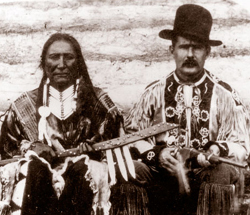| Français | Contact Us | Help | Search | Canada Site | ||||
| Home | A-Z Index | Scams/Fraud | Detachments | Publications | ||||



 |
|
| Home | |
| About the RCMP | |
| Organization | |
| RCMP Regions / Divisions | |
| Executive | |
| History | |
| Reports and Publications | |
| Musical Ride | |
| Best Practices | |
| Forms | |
| Priorities | |
| Programs and Services | |
| Newsroom | |
| Careers / Recruiting | |
Origins of the RCMP |
|
The American Sioux
In 1877, thousands of American Sioux refugees arrived in Canada threatening the order which the Mounted Police had helped bring to the prairies. For years the Sioux had been fighting a losing battle to protect their traditional hunting lands from the encroachment of white civilization.
 In
1875, the American authorities informed the Sioux that unless they settled
on the reserves allocated to them, they would be considered enemies
of the United States. The Sioux refused, and in the spring of 1876 the
United States Army began a campaign to force them onto the reserves.
The climax of the Sioux resistance came at Little Big Horn in June,
1876, with the annihilation of five 7th United States Cavalry troops
under the command of Lieutenant Colonel George A. Custer. Custer's defeat,
however, was the beginning of the end. The Sioux could not hope to defeat
the large military forces now closing on them from all sides. Tired
and hungry, they gradually retreated northward to seek refuge in Canadian
Territory.
In
1875, the American authorities informed the Sioux that unless they settled
on the reserves allocated to them, they would be considered enemies
of the United States. The Sioux refused, and in the spring of 1876 the
United States Army began a campaign to force them onto the reserves.
The climax of the Sioux resistance came at Little Big Horn in June,
1876, with the annihilation of five 7th United States Cavalry troops
under the command of Lieutenant Colonel George A. Custer. Custer's defeat,
however, was the beginning of the end. The Sioux could not hope to defeat
the large military forces now closing on them from all sides. Tired
and hungry, they gradually retreated northward to seek refuge in Canadian
Territory.
The Sioux's arrival disturbed the peaceful relations which
Canada was in the process of establishing with its own tribes. The
Sioux were traditional enemies of many Canadian First Nations. Their
presence would strain the already dwindling buffalo herds.
The North-West Mounted Police task was a difficult one. The Sioux
would have to be closely watched. There must be no revival of intertribal
warfare. The Sioux must obey Canadian laws and, above all, they must
not be allowed to attack the United States using Canadian territory
as a base. Fort Walsh in the Cypress Hills now became the Force's main
centre of operations. The post, established there in 1875, was reinforced
and enclosed by a fortified stockade. In 1878, NWMP headquarters was
moved from Fort Macleod to Fort Walsh, in recognition of its new importance.
Scouts brought the first news of the Sioux migrating to Fort Walsh in
November 1876. A large party of Sioux, they reported, were moving north
towards the trading post at Wood Mountain. Within a few days, Supt. Walsh
and a party of twelve Mounted Police were on their way east to meet with
the refugees.
Arriving at Wood Mountain, Walsh found about 2000 Sioux under Black Moon,
the tribe's hereditary chief, camped close to the trading post. A council
was called. They informed Walsh that they were tired of being hunted;
they had come to the land of the Great White Mother to find refuge. Walsh
warned them firmly that they must obey Canada's law and above all, they
must not raid the United States.
Early in 1877, two more Sioux groups followed Black Moon's band: the first
under Chief Four Horns, and finally a large band under Sitting Bull, now
recognized as the leader of the Sioux resistance.
By summer, 1878, it began to look as if the Sioux would remain in Canada
for good. In spite of negotiations between the Canadian and American Governments,
they still refused to return to the United States. Dwindling buffalo herds
soon accomplished what diplomacy failed to do. As their traditional source
of food diminished, the Sioux began to realize they must accept a sedentary
way of life. There was no point in defending a land now empty of buffalo.
The Canadian government continued to insist on the Sioux's refugee status,
with no intention of granting them reserves north of the border. They
must return south.
By 1879, Sitting Bull's influence was on the decline and small bands of
Sioux began returning to the United States. The Sioux leader and a small
group of intransigents still refused to trust the Americans. The Macdonald
government decided to take a firmer stand. In 1880, the Mounted Police
were instructed to visit the remaining Sioux camps and warn them that
the government would no longer supply them with food. They would starve
unless they returned to the United States. A year later the last band,
led by Sitting Bull, surrendered to the American authorities at Fort Buford,
North Dakota.
| Content created: 2002-09-01 Content revised: date |
Return to Top | Important Notices |